Commonly asked: Can you bonsai a giant sequoia? Yes, a giant sequoia can be “bonsai-ed.” You can, but it takes more patience and care than most bonsai beginners expect.
The Sequoiadendron giganteum is a species of coniferous tree, classified in the family Cupressaceae in the subfamily Sequoioideae. Giant sequoia specimens are the largest trees on Earth.
It is challenging due to the tree’s natural growth habit, which is to grow massive and tall, as well as its wood’s brittle nature.
The process of dwarf plantation requires careful, yearly pruning, consistent fertilizing, a specific soil mix with good drainage, and constant effort to encourage lower branch development and prevent the upper growth from outcompeting the lower.
It is a battle to keep the lower branches alive and encourage the right form, though some sources indicate success is possible.
You’ve seen a giant sequoia forest or admired the size of a coastal redwood and thought about capturing that same power in a bonsai plant at home.
The truth is, while you can train a giant sequoia into a miniature form, you must be ready for challenges like constant bonsai pruning, protecting fragile roots, and keeping the tree outdoors year-round.
Some growers even use a bonsai kit or start from giant sequoia seeds to build a single tree or even a bonsai forest, much like plantings of dawn redwood forest or Sequoia sempervirens bonsai.
With the right mix of pruning, watering, and outdoor placement, you can shape a living symbol of nature’s biggest trees into your own great bonsai, but only if you’re prepared for the work and commitment.
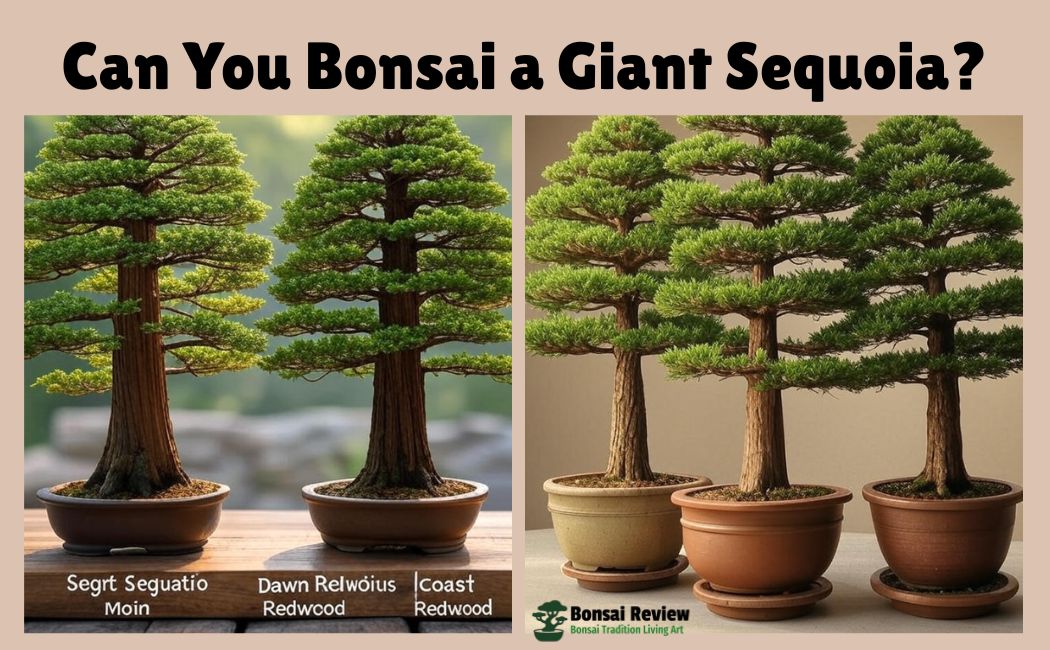
What is a Giant Sequoia?
A Giant Sequoia (Sequoiadendron Giganteum) is a massive, long-lived tree native to the western slopes of the Sierra Nevada mountain range in California, USA.
The giant sequoia trees of the Sierra Nevada are among the largest and oldest living things on Earth.
The largest tree IN THE WORLD (by volume) is one of the trees I visited. Some rise over 300 feet into the sky. But despite their immense height, they don’t have deep roots.
It is one of the largest tree species by volume in the world, known for its thick, reddish-brown bark and towering height, which can exceed 250 feet (76 meters).
These trees can live for over 3,000 years and are characterized by their conical shape, scale-like needles, and durable wood.
As a bonsai, it is cultivated in a miniature form, requiring careful pruning and maintenance to mimic its natural grandeur on a smaller scale.
Why Bonsai a Giant Sequoia?
You might wonder why anyone would try to turn the world’s largest tree into a bonsai plant. Can You Bonsai a Giant Sequoia? The answer is simple: Yes, but creating a bonsai from a giant sequoia (Sequoiadendron giganteum) lets you capture the feeling of standing in a towering forest inside a small pot.
These trees are symbols of strength, age, and endurance. Some artists even plant several together to form a sequoia bonsai forest, echoing the look of a natural grove.
Others are inspired by the beauty of a dawn redwood forest or the elegance of a coast redwood bonsai (Sequoia sempervirens) and want to try the most impressive version for themselves.
If you’ve ever dreamed of owning a “great bonsai” that reflects nature’s biggest trees, the giant sequoia is one of the boldest choices you can make.
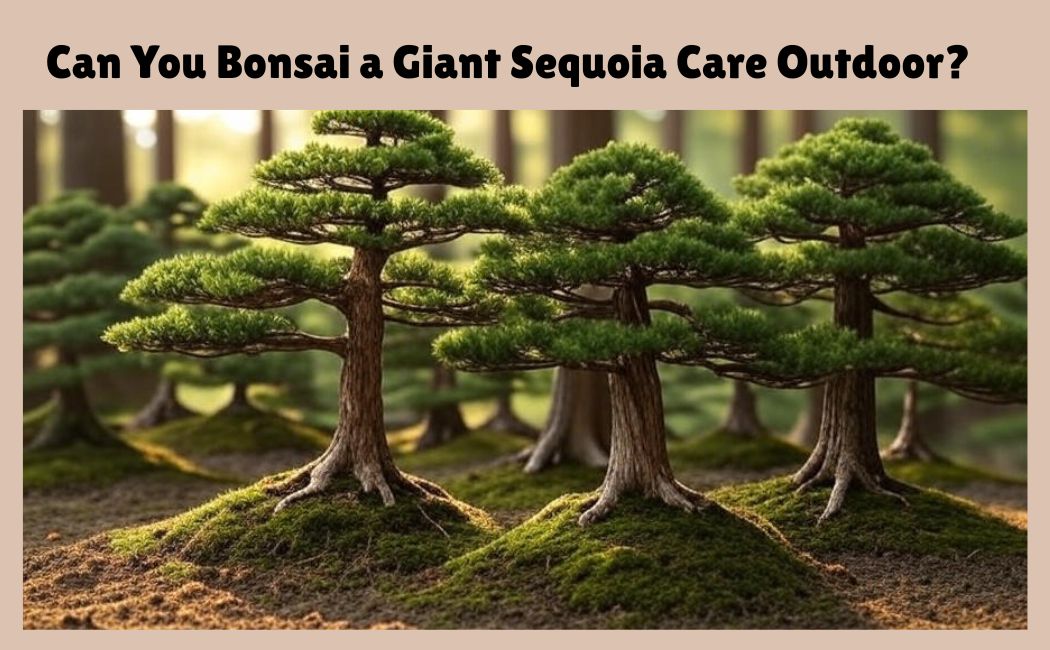
Can You Bonsai a Giant Sequoia? Challenges of Growing a Giant Sequoia Bonsai.
Before starting, it’s essential to know that a giant sequoia bonsai presents significant challenges. These trees grow fast and tall, so you’ll spend a lot of time on careful bonsai pruning to control their strong apical dominance.
The wood is brittle, which makes wiring tricky, and branches often snap instead of bending. Many growers use guy wires or rely on strategic pruning instead of healthy roots, which is another concern.
While a bonsai starter or sapling may look tough, the fine feeder roots are delicate and can die if you prune too much. Water is another battle. A giant sequoia loses moisture quickly, so the soil in your bonsai pot must stay damp, especially in hot summers.
In cold regions like Canadian weather zones, winter problems are common because dry winds can dehydrate the tree. Unlike small indoor trees, a sequoia bonsai cannot live as a bonsai indoors.
It must stay outdoors year-round to survive. All of this means it’s not the easiest choice for bonsai beginners, but if you want a real challenge, this is it.
How to Start a Giant Sequoia Bonsai?
A common question for beginner bonsai lovers: Can You Bonsai a Giant Sequoia? If you’re ready to try, you can begin your giant sequoia bonsai journey in two main ways: by planting giant sequoia seeds or by using a young sapling from a bonsai starter kit.
Seeds need a cold stratification period of about four weeks before they will sprout, so be patient during this stage. Once they germinate, keep the seedlings in a larger pot for the first few years so the trunk can thicken before moving them into a shallow bonsai container.
If you choose a sapling, you can skip the waiting and start shaping earlier, but you’ll still need to give it time to grow stronger roots. Some artists even buy a small group of trees to create a sequoia bonsai forest, capturing the look of a wild grove.
If you go with seeds or a starter plant, always use a well-draining bonsai soil mix and a pot with good airflow. With the right start, your sequoia can grow into a healthy bonsai plant that carries the spirit of a giant forest in miniature.
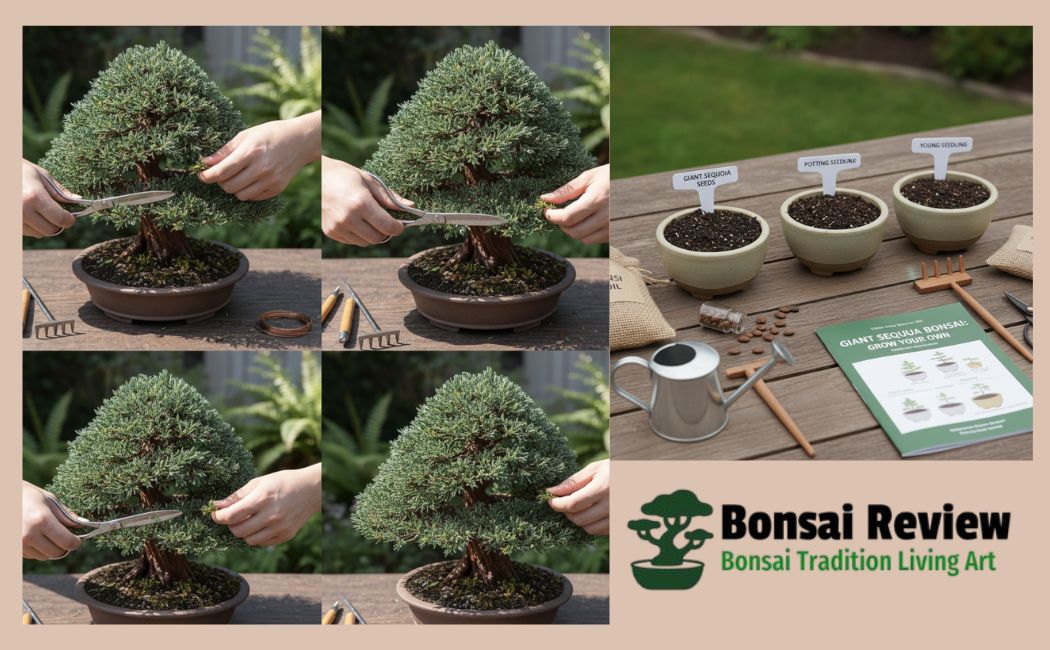
How Can You Care for a Giant Sequoia Bonsai?
Once your giant sequoia bonsai is established, daily care becomes the key to success. These dwarf trees love full sun, so place them outdoors where they can get plenty of light. Watering is critical for giant sequoias, which need damp soil, but not soggy roots.
Check the pot often in summer, as the soil dries faster than you expect. For soil, use a mix that drains well but holds enough moisture to keep the tree from drying out. Fertilize lightly during the growing season to support strong needles and trunk thickening.
Regular bonsai pruning will help keep the height under control, and trimming new growth often is better than cutting large branches later. Be gentle with wiring, since the brittle wood can snap.
Many growers prefer clip-and-grow shaping. During winter, protect the tree from harsh winds and drying cold.
In climates like Canadian winters, you may need to overwinter the bonsai in a cold frame or unheated garage where it stays cool but doesn’t freeze solid.
Can You Bonsai a Giant Sequoia? Get a real answer with steady care, your bonsai plant can thrive for decades and grow into a striking example of a “great bonsai.”
Styling Ideas: Can You Bonsai A Giant Sequoia?
When shaping a giant sequoia bonsai, the goal is to echo the majesty of full-sized trees. Many artists prefer the formal upright style, since it mirrors the straight, towering trunk of a natural Sequoiadendron giganteum.
If you plant several saplings together, you can create a sequoia bonsai forest, giving the same feel as walking through a giant sequoia forest or even a dawn redwood forest.
For dramatic effect, some growers style their trees like a coastal redwood bonsai (Sequoia sempervirens), emphasizing tall, slender lines. Because branches tend to grow outward and upward, clip-and-grow is often used to refine the shape rather than heavy wiring.
A well-styled tree should capture the spirit of age and strength, with a thick trunk, tapered top, and layered green pads that look like natural forest canopies.
Even in a small pot, this style makes your bonsai feel like a miniature monument to nature’s largest tree, a true great bonsai in living form.
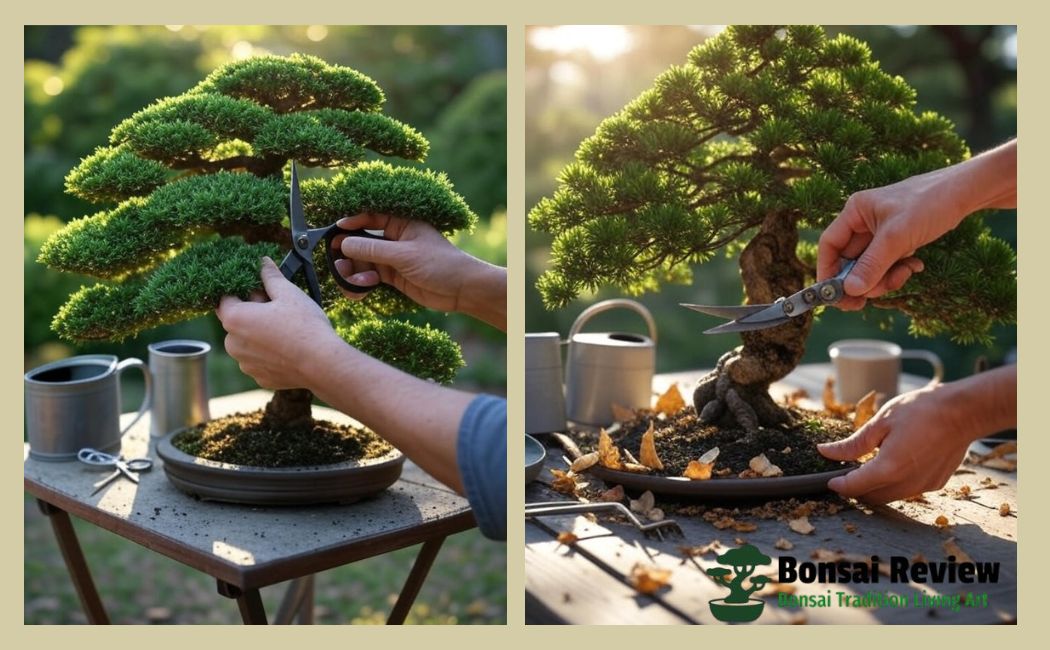
Redwood Species Comparison for Bonsai: Really! Can You Bonsai a Giant Sequoia?
| Feature | Giant Sequoia (Sequoiadendron giganteum) | Dawn Redwood (Metasequoia glyptostroboides) | Coast Redwood (Sequoia sempervirens) |
| Growth Habit | Evergreen conifer, fast vertical growth | A deciduous conifer loses needles in fall | Evergreen conifer, delicate fern-like foliage |
| Trunk Development | Thickens quickly, needs constant pruning | Thickens quickly, easier to shape | Develops taper with careful planning |
| Branches | Brittle, hard to wire | Flexible, back-buds easily, good for beginners | Flexible, can be wired lightly |
| Pruning | Frequent, precise control of size | Back-buds readily, simplifies styling | Requires careful timing, manageable |
| Foliage | Dense, scale-like, rigid | Soft, feathery, golden before fall | Delicate, elegant, dense when pinched |
| Ease of Care | Very challenging, best for advanced lovers | Excellent for beginners, resilient | Moderate difficulty, better than a giant sequoia |
| Climate | Cold-hardy, must stay outdoors | Very cold-hardy, outdoors | Less cold-tolerant, needs winter protection |
| Water & Feeding | High water and nutrient needs | Water-loving, grows fast | Likes humidity, soil must stay moist |
Unique indoor bonsai giant sequoia helps you quickly compare giant sequoia bonsai with its relatives, dawn redwood and coast redwood, so you can choose the best bonsai plant for your skill level and environment.
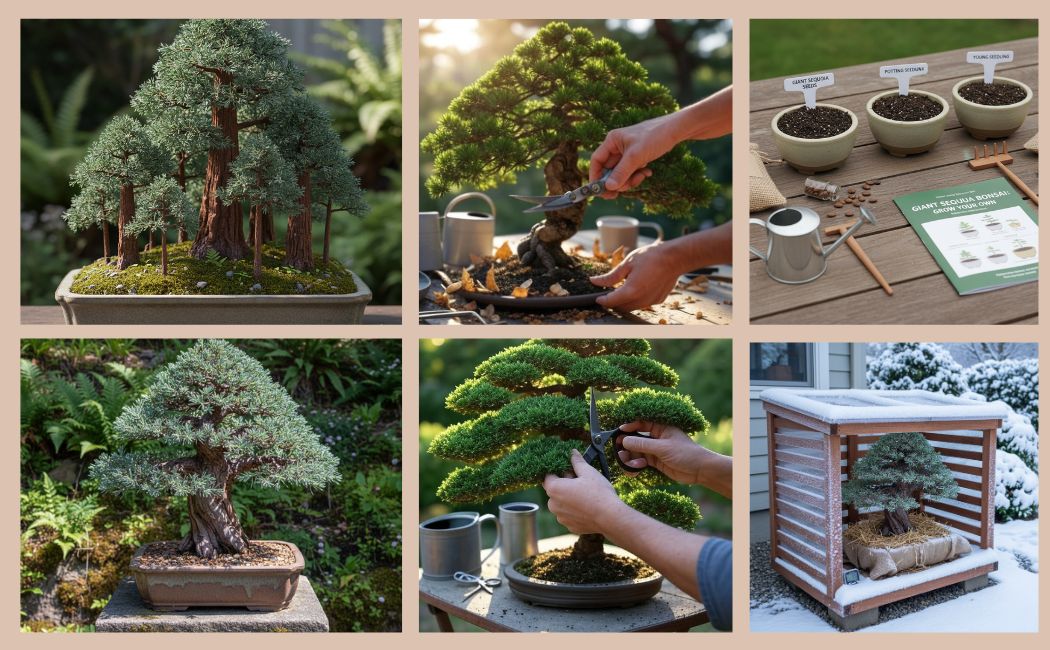
Common Problems and Troubleshooting: Can You Bonsai a Giant Sequoia?
Is a Giant Sequoia Bonsai Right for You? A giant sequoia bonsai is a challenging project best suited for experienced bonsai lovers, not beginners, as they are more difficult to care for in pots than their coastal redwood cousins.
They exhibit a strong tendency toward vertical growth, experience branch die-back in shaded areas, and require consistent moisture to prevent root issues and discoloration.
While their vigorous growth and potential for development are appealing, the care needed is intense and not recommended for novices.
| Problem | Signs | Causes | Solutions |
| Dehydration | Browning or crisping needles, brittle branches, dry soil | High water loss from foliage, hot or dry weather | Water frequently, mist foliage, check soil moisture deeply |
| Overwatering | Yellowing or soft needles, soggy soil, root rot | Soil stays waterlogged, poor drainage | Use well-draining soil, reduce watering, and inspect roots |
| Winter Dehydration | Browning needles, leaf drop, dry soil | Cold, dry winds, low humidity | Protect with a cold frame, bury the pot in snow, and provide a wind shelter |
| Pests & Diseases | Discolored or spotted needles, webbing, or abnormal growth | Spider mites, fungal infections | Inspect regularly, treat with appropriate insecticide/fungicide |
| Root Damage | Wilting, slow growth, trunk stress | Excessive or rough root pruning | Repot carefully, slice the root ball minimally, and maintain feeder roots |
| Branch or Wiring Issues | Snapped branches, wired branches rebounding | Brittle wood, improper wiring | Use guy wires, gentle clip-and-grow shaping, and avoid heavy wiring |
Can you bonsai a giant sequoia? It helps you quickly identify and solve common issues when growing a giant sequoia bonsai, keeping your bonsai plant healthy and thriving as a great bonsai.
Conclusion: Expert Tips for Beginners: Can You Bonsai a Giant Sequoia?
Get your answer about Can you bonsai a giant sequoia? Of course, A giant sequoia bonsai (Sequoiadendron giganteum) is one of the most impressive and rewarding bonsai plants you can grow, but it comes with real challenges.
Its rapid growth, brittle wood, and delicate roots mean you’ll need to commit to careful bonsai pruning, consistent watering, and outdoor placement year-round.
If you’re a bonsai beginner, starting with a dawn redwood or coast redwood bonsai may be a better option, as they are more forgiving while still offering that majestic redwood appearance.
For dedicated growers, a giant sequoia bonsai grown from giant sequoia seeds, a bonsai starter, or even arranged as a sequoia bonsai forest, can become a true great bonsai, capturing the spirit and grandeur of a towering giant sequoia forest in miniature form. With patience and proper care, your bonsai can thrive for decades, offering a living piece of nature’s most remarkable trees right in your own space.
More helpful article: What Is the Oldest Bonsai Tree in the World?
FAQs: Can you bonsai a giant sequoia?
1. Is it illegal to plant a giant sequoia?
No, planting a giant sequoia (Sequoiadendron giganteum) is legal in most areas, including the USA. However, check local regulations if you plan to grow it outdoors in a public or protected area.
2. Can you bonsai a redwood tree?
Yes, you can. Besides giant sequoia bonsai, other redwood species like dawn redwood (Metasequoia glyptostroboides) and coast redwood (Sequoia sempervirens bonsai) are also suitable for bonsai.
3. How do you keep a giant sequoia small?
Control growth through frequent bonsai pruning, tip pinching, careful root management, and regular repotting. Avoid withholding fertilizer, as these trees grow vigorously when well-fed.
4. Can you grow your own giant sequoia?
Yes, you can grow one from giant sequoia seeds or a nursery sapling. Seeds require cold stratification, and saplings need a few years of nursery growth before shaping into bonsai.
5. Can you bonsai a giant sequoia indoors?
No, giant sequoias must remain outdoors year-round. They require natural sunlight, humidity, and a dormant winter period to survive long-term. Indoor conditions are too dry and warm for healthy growth.
6. How long does it take for a giant sequoia bonsai to mature?
It can take several years, sometimes decades, to develop a thick trunk, dense foliage, and a refined shape. Patience is essential for creating a great bonsai.
7. What are common signs of dehydration in a giant sequoia bonsai?
Look for browning or crisping needles, brittle branches, drooping foliage, or dry soil deep in the pot. Early detection and frequent watering are key to survival.
8. Why are sequoias so special?
The giant sequoia trees of the Sierra Nevada are among the largest and oldest living things on Earth. The largest tree IN THE WORLD (by volume) is one of the trees I visited. Some rise over 300 feet into the sky. But despite their immense height, they don’t have deep roots.
9. What does the Bible say about sequoia trees?
The mountains and hills will lead the parade, bursting with song. All the trees of the forest will join the procession, exuberant with applause. Isaiah 55:13 In-Context No more thistles, but giant sequoias, no more thornbushes, but stately pines – Monuments to me, to God, living and lasting evidence of God.”